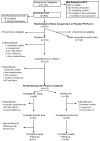Low-dose amitriptyline for treatment of persistent arm pain due to repetitive use
- PMID: 20172654
- PMCID: PMC2908294
- DOI: 10.1016/j.pain.2010.01.016
Low-dose amitriptyline for treatment of persistent arm pain due to repetitive use
Abstract
Amitriptyline is sometimes used to treat arm pain related to repetitive use, but rigorous evidence of its benefit is lacking. This randomized controlled trial investigated whether amitriptyline provided greater pain relief or improved arm function than a placebo pill in adults with arm pain associated with repetitive use that had persisted for at least 3 months. Participants (N=118) were randomly assigned to receive 25mg of amitriptyline or a placebo pill for 6 weeks. The primary outcome was intensity of pain (10-point numerical rating scale) and secondary outcomes were arm symptoms, arm function, grip strength, mood, and sleep. Assessments were done at baseline, 3 and 6 weeks of treatment, and 1 month after the treatment ended. Changes in arm pain were not statistically significant. However, the amitriptyline group improved more than the placebo group in arm function (p=0.023) and sense of well being (p=0.034). In a longitudinal analysis, the amitriptyline group's arm function score improved 0.45 points per week faster than placebo after adjusting for subject characteristics (p=0.015). At the treatment's midpoint, the amitriptyline group reported more "troublesome side-effects" than the placebo group (52.5% vs. 27.1%, p=0.005), but this difference decreased by the end of the treatment (30.5% vs. 22.0%, p=0.30). The most frequent side effect was drowsiness. In conclusion, this study found that low-dose amitriptyline did not significantly decrease arm pain among these participants but did significantly improve arm function and well being. Future research is needed to explore the effects of higher doses and longer duration of treatment.
Copyright 2010 International Association for the Study of Pain. All rights reserved.
Figures
Similar articles
-
Sham device v inert pill: randomised controlled trial of two placebo treatments.BMJ. 2006 Feb 18;332(7538):391-7. doi: 10.1136/bmj.38726.603310.55. Epub 2006 Feb 1. BMJ. 2006. PMID: 16452103 Free PMC article. Clinical Trial.
-
Evaluating amitriptyline's role in chronic TMD management: a placebo-controlled trial.BMC Oral Health. 2025 Mar 4;25(1):334. doi: 10.1186/s12903-025-05670-7. BMC Oral Health. 2025. PMID: 40038711 Free PMC article. Clinical Trial.
-
Low-dose titrated amitriptyline as second-line treatment for adults with irritable bowel syndrome in primary care: the ATLANTIS RCT.Health Technol Assess. 2024 Oct;28(66):1-161. doi: 10.3310/BFCR7986. Health Technol Assess. 2024. PMID: 39397570 Free PMC article. Clinical Trial.
-
High doses of topical amitriptyline in neuropathic pain: two cases and literature review.Pain Pract. 2012 Feb;12(2):148-53. doi: 10.1111/j.1533-2500.2011.00477.x. Epub 2011 Jun 16. Pain Pract. 2012. PMID: 21676162 Review.
-
Amitriptyline for fibromyalgia in adults.Cochrane Database Syst Rev. 2019 May 28;5(7):CD011824. doi: 10.1002/14651858.CD011824. Cochrane Database Syst Rev. 2019. PMID: 35658166 Free PMC article. Review.
Cited by
-
Conservative interventions for treating work-related complaints of the arm, neck or shoulder in adults.Cochrane Database Syst Rev. 2013 Dec 12;2013(12):CD008742. doi: 10.1002/14651858.CD008742.pub2. Cochrane Database Syst Rev. 2013. PMID: 24338903 Free PMC article.
-
Antidepressants for pain management in adults with chronic pain: a network meta-analysis.Cochrane Database Syst Rev. 2023 May 10;5(5):CD014682. doi: 10.1002/14651858.CD014682.pub2. Cochrane Database Syst Rev. 2023. PMID: 37160297 Free PMC article. Review.
-
Adverse Effects of Antidepressants for Chronic Pain: A Systematic Review and Meta-analysis.Front Neurol. 2017 Jul 14;8:307. doi: 10.3389/fneur.2017.00307. eCollection 2017. Front Neurol. 2017. PMID: 28769859 Free PMC article.
-
Psychiatric disorders and pain: The recurrence of a comorbidity.World J Clin Cases. 2022 Sep 26;10(27):9550-9555. doi: 10.12998/wjcc.v10.i27.9550. World J Clin Cases. 2022. PMID: 36186191 Free PMC article. Review.
-
Amitriptyline's anticholinergic adverse drug reactions-A systematic multiple-indication review and meta-analysis.PLoS One. 2023 Apr 5;18(4):e0284168. doi: 10.1371/journal.pone.0284168. eCollection 2023. PLoS One. 2023. PMID: 37018325 Free PMC article.
References
-
- Ashina S, Bendtsen L, Jensen R. Analgesic effect of amitriptyline in chronic tensiontype headache is not directly related to serotonin reuptake inhibition. Pain. 2004;108:108–114. - PubMed
-
- Bureau of Labor Statistics (U.S. Department of Labor) Repetitive motion leads to longest work absences.
-
- Daut RI, Cleeland CS, Flanery RC. Development of the Wisconsin Brief Pain Questionnaire to assess pain in cancer and other diseases. Pain. 1983;17:197–210. - PubMed
-
- Fazio AF. A concurrent validational study of the NCHS Well-Being Schedule - PubMed
Publication types
MeSH terms
Substances
Grants and funding
LinkOut - more resources
Full Text Sources



